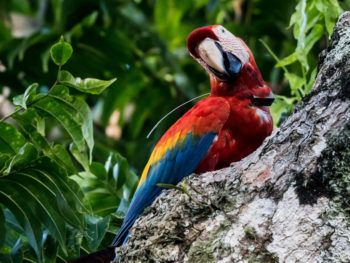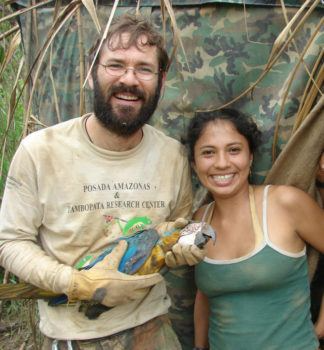New System For Tracking Macaws Emphasizes Species’ Conservation Needs
Researchers with Texas A&M's Macaw Society used satellite telemetry to track the movements of 10 birds over a period of 8 years.

New data on macaw movements gathered by the Texas A&M University College of Veterinary Medicine & Biomedical Sciences’ (CVMBS) The Macaw Society has the potential to greatly improve conservation strategies for the scarlet macaw, as well as similar species of large parrots.
While the overall conservation status of the scarlet macaw is listed as “least concern” by the International Union for Conservation of Nature, the species is declining across much of Central America and in other parts of its range in South America. The species also shares its habitat with numerous endangered species and influences the ecosystems in which it lives.
The Macaw Society’s paper, recently published in Avian Conservation & Ecology, is the result of the long-term research study of the ecology and conservation of macaws and other parrots in Peru’s Tambopata National Reserve.
Historically, the migratory movements of large parrots and macaws have largely remained a mystery because of the difficulty of tracking them over the long distances they travel. The recent publication describing the discoveries made using satellite tracking of individual birds over large areas has shed some light on this mystery.
The research team — consisting of associate professor Donald Brightsmith; adjunct associate professor Janice Boyd; Elizabeth Hobson from the University of Cincinnati; and Charles Randel from the Southwestern Wildlife Survey in California — used ARGOS satellite telemetry (orbiting satellites that detect signals emitted from a transmitter attached to an animal) to track six scarlet macaws and four blue-and-yellow macaws over a period of eight years.
They found that both macaw species had very large home ranges, consisting of thousands of hectares (with 1 hectare equaling 2.471 acres), and often traveled 20 to 40 km (approximately 12 to 25 miles) per day. Individuals of both species moved up to 160 km (99 miles) during the periods of low food availability, likely searching for areas with dense patches of food trees.

“In Southeastern Peru, there are really large protected areas, a million hectares or so (approximately 2.47 million acres), but there’s always pressure to use land versus conserve it,” Brightsmith said. “So how do we, as conservationists and scientists, justify that we need to conserve such large areas? Why not just save 50 hectares and assume that everything will be able to survive?
“The reality is, that’s not the case,” he said. “In fact, we found that a lot of the birds left protected areas and flew beyond the one million hectares.”
The team also discovered that after the breeding season ended, nearly all of the macaws left the large national parks and protected reserves. This highlights the importance of protecting more than just their nesting location.
“There’s this whole other time of the year when they’re far away,” Brightsmith said. “We need to be thinking about what they need to survive in that part of the landscape, too.”
For this project, the team overcame another challenge researchers have faced when trying to track macaws — the birds are extremely intelligent, making it difficult to trap them and attach a transmitter that the birds couldn’t remove.
To solve this problem, the researchers used a variety of trapping methods and special ARGOS satellite telemetry collars developed in 2013 by Brightsmith and Boyd, in collaboration with the electronics company Telonics and other industry partners. The system they developed will greatly improve macaw and parrot conservation methods and is already in use in Belize, Costa Rica, Guatemala and Bolivia.
“Our colleagues in Guatemala have found that a lot of macaws will pick up from their breeding grounds in Guatemala, fly long distances to nearby Mexico to spend the non-breeding season there, and then move back. Understanding the birds’ ability to move from one big chunk of land to another and that those two populations are actually linked is very important,” Brightsmith said. “It shows us what size area we have to be concerned about and where they are likely to be threatened by deforestation or hunting.”
The Macaw Society’s next major projects will involve sharing knowledge and best practices with other researchers and conservationists in South and Central America.
“A lot of what we’re doing now is advising organizations in Costa Rica, Brazil, Argentina, Mexico, Guatemala and other countries,” Brightsmith said. “Researchers and conservationists working in ‘parrot range nations’ have really stepped up. The field is much more developed than it was when I got started, and that’s really wonderful.”
Brightsmith hopes that the results from this project will not only have a direct impact on the macaws in Peru, but also positively impact other macaws and large parrots, protect native habitats, and increase public interest in conservation throughout the Americas.
“Macaws are really attractive; when people see them, they are always super impressed, so macaws are a good way to connect with regular people and communicate major conservation issues,” said Gabriela Vigo-Trauco, CVMBS postdoctoral research associate and co-director of The Macaw Society. “If you can convince people that it’s important to conserve one species and that species moves so much and needs so much forest, you are in a good position to protect that entire space and everything else using it.”
Follow The Macaw Society on Facebook to learn more about their current projects and view livestreams of macaw nests in Costa Rica.
Publication: Brightsmith, D. J., et al., Satellite telemetry reveals complex migratory movement patterns of two large macaw species in the western Amazon basin, Avian Conservation and Ecology (2023). DOI: 10.5751/ACE-01822-160114
Original Story Source: Texas A&M University

 Alerts Sign-up
Alerts Sign-up